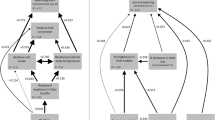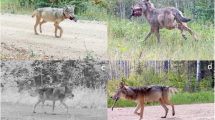Abstract
Competition among mammalian siblings for scarce resources can be severe. Whereas research to date has focused on competition for the mother’s milk, the young of many (particularly altricial) species might also be expected to compete for thermally favorable positions within the nest, den, or litter huddle. We investigated this in newborn pups of the European rabbit Oryctolagus cuniculus, a species in which the altricial young are not brooded by the mother, and in which competition for milk is severe. In eight unculled litters (N = 86 pups) of a domestic chinchilla strain, we calculated huddling indexes for individual pups on postnatal days 2–5 as a measure of the degree of insulation they received from littermates. Pups maintained almost constant physical contact with the litter huddle. They performed brief but frequent rooting and climbing behaviors, which usually improved their huddling index, interspersed with longer periods of quiescence during which their huddling index declined. As expected, we found a significant positive relation between pups’ mean huddling index and body temperature. Unexpectedly, however, we did not find a relation between huddling index and pups’ birth weight, survival, milk intake, or efficiency of converting milk to body mass. We conclude that rather than competing for thermally advantageous positions within the huddle newborn rabbits share out thermally advantageous positions as they move in a continual dynamic flow through it. Thus, in newborn rabbits, competition for the mother’s milk exists alongside mutual “cooperative” benefits of littermate presence.



Similar content being viewed by others
References
Alberts JR (1978a) Huddling by rat pups: multisensory control of contact behavior. J Comp Physiol Psychol 92:220–230
Alberts JR (1978b) Huddling by rat pups: group behavioral mechanisms of temperature regulation and energy conservation. J Comp Physiol Psychol 92:231–245
Bautista A, Drummond H, Martínez-Gómez M, Hudson R (2003) Thermal benefit of sibling presence in the newborn rabbit. Dev Psychobiol 43:208–215
Bautista A, Mendoza-Degante M, Coureaud G, Martínez-Gómez M, Hudson R (2005) Scramble competition in newborn domestic rabbits for an unusually restricted milk supply. Anim Behav 70:1011–1021
Bernard E, Hull D (1964) The effect of the environmental temperature on the growth of new-born rabbits reared in incubators. Biol Neonate 7:172–178
Blumberg MS, Sokoloff G (1998) Thermoregulatory competence and behavioral expression in the young of altricial species-revisited. Dev Psychobiol 33:107–123
Canali E, Ferrante V, Todeschini R, Verga M, Carenzi C (1991) Rabbit nest construction and its relationship with litter development. Appl Anim Behav Sci 31:259–266
Coureaud G, Schaal B, Coudert P, Hudson R, Rideaud P, Orgeur P (2000a) Mimicking natural nursing conditions promotes early pup survival in domestic rabbits. Ethology 106:207–225
Coureaud G, Schaal B, Coudert P, Rideaud, P, Fortun-Lamothe L, Hudson R, Orgeur P (2000b) Immediate postnatal suckling in the rabbit: its influence on pup survival and growth. Reprod Nutr Dev 40:19–32
Denenberg HV, Wyly VM, Burns JK, Zarrow XM (1973) Behavioral effects of handling rabbits in infancy. Brain Res Pub 10:1001–1004
Deutsch JA (1957) Nest building behaviour of domestic rabbits under semi-natural conditions. Br J Anim Behav 5:53–54
Drake A, Fraser D, Weary DM (2007) Parent–offspring resource allocation in domestic pigs. Behav Ecol Sociobiol DOI 10.1007/s00265-007-0418-y
Drummond H (2001) A reevaluation of the role of food in broodmate aggression. Anim Behav 61:517–526
Drummond H (2006) Dominance in vertebrate broods and litters. Q Rev Biol 81:3–32
Drummond H, Vázquez E, Sánchez-Colón S, Martínez-Gómez M, Hudson R (2000) Competition for milk in the domestic rabbit: survivors benefit from littermate deaths. Ethology 106:511–526
Fey K, Trillmich F (2007) Sibling competition in guinea pigs (Cavia aperea f. porcellus): scrambling for mother’s teats is stressful. Behav Ecol Sociobiol DOI 10.1007/s00265-007-0419-x
Forbes LS (2005) A natural history of families. Princeton University Press, Princeton, NJ
Freeman NCG, Rosenblatt JS (1978) The interrelationship between thermal and olfactory stimulation in the development of home orientation in newborn kittens. Dev Psychobiol 11:437–457
González-Mariscal G, Rosenblatt JS (1996) Maternal behavior in rabbits. In: Rosenblatt JS, Snowdon CT (eds) Parental care: evolution, mechanisms and adaptive significance. Advances in the study of behavior, vol 25. Academic, New York, pp 333–360
Harri M, Mononen J, Haapanen K, Korhonen H (1991) Postnatal changes in hypothermic response in farmborn blue foxes and raccoon dogs. J Therm Biol 16:71–76
Hofer H, East ML (2007) Siblicide in Serengeti spotted hyenas: a long-term study of maternal input and cub survival. Behav Ecol Sociobiol DOI 10.1007/s00265-007-0421-3
Hudson R, Distel H (1982) The pattern of behaviour of rabbit pups in the nest. Behaviour 79:255–272
Hudson R, Distel H (1983) Nipple location by newborn rabbits: behavioural evidence for pheromonal guidance. Behaviour 85:260–275
Hudson R, Distel H (1986) The potential of the newborn rabbit for behavioral teratological research. Neurobehav Toxicol Teratol 8:209–212
Hudson R, Distel H (1989) Temporal pattern of suckling in rabbit pups: a model of circadian synchrony between mother and young. In: Reppert SM (ed) Development of circadian rhythmicity and photoperiodism in mammals. Research in perinatal medicine, vol IX. Perinatology, Boston, pp 83–102
Hudson R, Distel H (1990) Sensitivity of female rabbits to changes in photoperiod as measured by pheromone emission. J Comp Physiol A 167:225–230
Hudson R, Trillmich F (2007) Sibling competition and cooperation in mammals: challenges, developments and prospects. Behav Ecol Sociobiol DOI 10.1007/s00265-007-0417-z
Hudson R, Bilkó Á, Altbäcker V (1996) Nursing, weaning and the development of independent feeding in the rabbit (Oryctolagus cuniculus). Z Säugetierkd 61:39–48
Hudson R, Cruz Y, Lucio RA, Ninomiya J, Martínez-Gómez M (1999) Temporal and behavioral patterning of parturition in rabbits and rats. Physiol Behav 66:599–604
Hull D (1965) Oxygen consumption and body temperature of new-born rabbits and kittens exposed to cold. J Physiol 177:192–202
Hull J, Hull D (1982) Behavioral thermoregulation in newborn rabbits. J Comp Physiol Psychol 96:143–147
Jilge B, Hudson R (2001) Diversity and development of circadian rhythms in the European rabbit. Chronobiol Int 18:1–26
Leonard C (1974) Thermotaxis in golden hamster pups. J Comp Physiol Psychol 3:458–469
Leonard C (1982) Shifting strategies of behavioral thermoregulation in developing golden hamsters. J Comp Physiol Psychol 96:234S–243S
Martínez-Gómez M, Juárez M, Distel H, Hudson R (2004) Overlapping litters and reproductive performance in the domestic rabbit. Physiol Behav 82:629–636
Mock DW, Parker GA (1997) The evolution of sibling rivalry. Oxford University Press, Oxford
Mock DW, Parker GA, Schwagmeyer PH (1998) Game theory, sibling rivalry, and parent-offspring conflict. In: Dugatkin LA, Reeve HK (eds) Game theory and animal behavior. Oxford University Press, New York, pp 146–167
Ogilvie DM, Stinson RH (1966) The effect of age on temperature selection by laboratory mice (Mus musculus). Can J Zool 44:511–517
Pacheco-Cobos L, Rosetti M, Distel H, Hudson R (2003) To stay or not to stay: the contribution of tactile and thermal cues to coming to rest in newborn rabbits. J Comp Physiol A 189:383–389
Rheingold HL (1963) Maternal behavior in mammals. Wiley, New York
Roshan PD, Greene HSN (1936) The influence of intrauterine factors on the fetal weight of rabbits. J Exp Med 63:901–921
Ross S, Denenberg VH, Sawin PB, Meyer P (1956) Changes in nest-building behaviour in multiparous rabbits. Br J Anim Behav 4:69–74
Rouvinen-Watt K, Harri M (2001) Observations on thermoregulatory ontogeny of mink (Mustela vison). J Therm Biol 26:9–14
Satinoff E, McEwen GN, Williams BA (1976) Behavioral fever in newborn rabbits. Science 193:1139S–1140S
Schank JC, Alberts JR (1997) Self-organized huddles of rat pups modeled by simple rules of individual behavior. J theor Biol 189:11–25
Schneider JR, Veltri AM, DeGraw WA, French JA (1995) Telemetered temperature in preweanling Mongolian gerbils (Meriones unguiculatus). Physiol Behav 57:199–203
Sokal M, Sinclair J (1976) Effect of temperature on growth of newborn rabbits. Biol Neonate 28:1–11
Sokoloff G, Blumberg MS (2001) Competition and cooperation among huddling infant rats. Dev Psychobiol 39:65–75
Stockley P, Parker GA (2002) Life history consequences of mammal sibling rivalry. Proc Nat Acad Sci USA 99:12932–12937
Sulloway JF (1996) Born to rebel. Pantheon, New York
Sulloway JF (2001) Birth order, sibling competition, and human behavior. In: Davies PS, Harmon RH (eds) Conceptual challenges in evolutionary psychology: innovative research strategies. Kluwer, Boston, pp 39–83
Trillmich F, Wolf JBW (2007) Parent-offspring and sibling conflict in Galápagos fur seals and sea lions. Behav Ecol Sociobiol DOI 10.1007/s00265-007-0423-1
White P (2007) Maternal response to neonatal sibling conflict in the spotted hyena (Crocuta crocuta) Behav Ecol Sociobiol DOI 10.1007/s00265-007-0422-2
Zarrow MX, Farooq A, Denenberg VH, Sawin PB, Ross S (1963) Maternal behavior in the rabbit: endocrine control of maternal-nest building. J Reprod Fertil 6:375–383
Zarrow MX, Denenberg VH, Anderson CO (1965) Rabbit: frequency of suckling in the pup. Science 150:1835–1836
Acknowledgment
This work was supported by grants from CONACyT (25889-N; 124936; 153843), PAPIIT (IN 217100), and PROMEP (UATlax 149; 103.5/04/2849/UATLAXCA-26). We thank Carolina Rojas, Laura García, and Cecilia Cuatianquiz for excellent technical assistance, Hans Distel for help with data analysis, Gerhard Dierlich and Arturo Estrada-Torres for statistical advice, Fritz Trillmich for valuable comments on the manuscript, and Hugh Drummond, Constantino Macías García, and other members of Los Lunáticos for valuable discussion. Throughout the study, animals were kept and treated according to the guidelines for the treatment of animals in research of the Instituto de Investigaciones Biomédicas, Universidad Nacional Autónoma de México, and according to the current laws of Mexico.
Author information
Authors and Affiliations
Corresponding author
Additional information
Communicated by A. Schulte-Hostedde
This contribution is part of the special issue “Sibling competition and cooperation in mammals” (guest editors: Robyn Hudson and Fritz Trillmich).
Rights and permissions
About this article
Cite this article
Bautista, A., García-Torres, E., Martínez-Gómez, M. et al. Do newborn domestic rabbits Oryctolagus cuniculus compete for thermally advantageous positions in the litter huddle?. Behav Ecol Sociobiol 62, 331–339 (2008). https://doi.org/10.1007/s00265-007-0420-4
Received:
Revised:
Accepted:
Published:
Issue Date:
DOI: https://doi.org/10.1007/s00265-007-0420-4




